Deposition of Crystalline GdIG Samples Using Metal Organic Decomposition Method
Abstract
:1. Introduction
2. Materials and Methods
3. Results
3.1. Structural Properties
3.2. Magnetic Property
3.3. FMR Measurement
4. Conclusions
Author Contributions
Funding
Institutional Review Board Statement
Informed Consent Statement
Data Availability Statement
Conflicts of Interest
Abbreviations
| MOD | Metal Organic Decomposition; |
| FMR | Ferromagnetic resonance; |
| REIG | Rare Earth Iron garnet; |
| YIG | Yttrium Iron garnet; |
| GdIG | Gadolinium Iron garnet; |
| GGG | Gadolinium Gallium Garnet; |
| AFM | Atomic Force Microscopy; |
| XRD | X-ray Diffraction; |
| TEM | Transmission of Electron Microscope; |
| EDX | Energy Dispersive X-ray spectroscopy; |
| PVP | PolyVinylPyrrolidone; |
| DMF | DiMethylFormamide; |
| SQUID | Superconducting Quantum Interference Vibrating System; |
| VSM | Vibrational Sample Magnetometer; |
| PPMS | Physical Property Measurement System; |
| MPMS | Magnetic Property Measurement System; |
| PLD | Pulsed Laser Deposition. |
References
- Keffer, F.; Kittel, C. Theory of antiferromagnetic resonance. Phys. Rev. 1952, 85, 329. [Google Scholar] [CrossRef]
- Keffer, F.; Kaplan, H.; Yafet, Y. Spin Waves in Ferromagnetic and Antiferromagnetic Materials. Am. J. Phys. 1953, 21, 253. [Google Scholar] [CrossRef]
- Kim, C.; Lee, S.; Kim, H.G.; Park, J.H.; Moon, K.W.; Park, J.Y.; Yuk, J.M.; Lee, K.J.; Park, B.G.; Kim, S.K.; et al. Distinct handedness of spin wave across the compensation temperatures of ferrimagnets. Nat. Mater. 2020, 19, 980–985. [Google Scholar] [CrossRef] [PubMed]
- Zhang, S.; Li, Z. Roles of nonequilibrium conduction electrons on the magnetization dynamics of ferromagnets. Phys. Rev. Lett. 2004, 93, 127204. [Google Scholar] [CrossRef] [Green Version]
- Cao Van, P.; Surabhi, S.; Dongquoc, V.; Kuchi, R.; Yoon, S.G.; Jeong, J.R. Effect of annealing temperature on surface morphology and ultralow ferromagnetic resonance linewidth of yttrium iron garnet thin film grown by rf sputtering. Appl. Surf. Sci. 2018, 435, 377–383. [Google Scholar] [CrossRef]
- Gomi, M.; Tanida, T.; Abe, M. Rf sputtering of highly Bi-substituted garnet films on glass substrates for magneto-optic memory. J. Appl. Phys. 1985, 57, 3888. [Google Scholar] [CrossRef]
- Lee, H.; Yoon, Y.; Kim, S.; Yoo, H.K.; Melikyan, H.; Danielyan, E.; Babajanyan, A.; Ishibashi, T.; Friedman, B.; Lee, K. Preparation of bismuth substituted yttrium iron garnet powder and thin film by the metal-organic decomposition method. J. Cryst. Growth 2011, 329, 27–32. [Google Scholar] [CrossRef]
- Uchida, T.; Watanabe, S.; Uchiyama, T.; Tachiki, T. Fabrication of STO buffer films on MgO substrates by the MOD method. J. Phys. Conf. Ser. 2008, 97, 012057. [Google Scholar] [CrossRef]
- Geprägs, S.; Kehlberger, A.; Coletta, F.D.; Qiu, Z.; Guo, E.J.; Schulz, T.; Mix, C.; Meyer, S.; Kamra, A.; Althammer, M.; et al. Origin of the spin Seebeck effect in compensated ferrimagnets. Nat. Commun. 2016, 7, 10452. [Google Scholar] [CrossRef] [Green Version]
- Liu, G.; Wang, X.; Luan, Z.Z.; Zhou, L.F.; Xia, S.Y.; Yang, B.; Tian, Y.Z.; Guo, G.; Du, J.; Wu, D. Magnonic Unidirectional Spin Hall Magnetoresistance in a Heavy-Metal–Ferromagnetic-Insulator Bilayer. Phys. Rev. Lett. 2021, 127, 207206. [Google Scholar] [CrossRef]
- Dong, B.W.; Cramer, J.; Ganzhorn, K.; Yuan, H.Y.; Guo, E.J.; Goennenwein, S.T.B.; Klaui, M. Spin Hall magnetoresistance in the non-collinear ferrimagnet GdIG close to the compensation temperature. J. Phys. Condens. Matter 2018, 30, 035802. [Google Scholar] [CrossRef]
- Thi, T.N.; Van, P.C.; Viet, D.D.; Quoc, V.D.; Ahn, H.; Cao, V.A.; Kang, M.G.; Nah, J.; Park, B.G.; Jeong, J.R. Morphology-dependent spin Seebeck effect in yttrium iron garnet thin films prepared by metal-organic decomposition. Ceram. Int. 2021, 47, 16770–16775. [Google Scholar] [CrossRef]
- Zhang, D.; Jin, L.; Zhang, H.; Yang, Q.; Rao, Y.; Wen, Q.; Zhou, T.; Liu, C.; Zhong, Z.; Xiao, J.Q. Chemical epitaxial growth of nm-thick yttrium iron garnet films with low Gilbert damping. J. Alloys Compd. 2017, 695, 2301–2305. [Google Scholar] [CrossRef]
- Dongquoc, V.; Kuchi, R.; Van, P.C.; Surabhi, S.; Lee, S.W.; Kim, D.; Jeong, J.R. Enhancing magneto-optical and structural properties of Bi-YIG thin film on glass substrate using poly[vinylpyrrolidone](PVP) assisted MOD method. Ceram. Int. 2019, 45, 20758–20761. [Google Scholar] [CrossRef]
- Yang, B.; Xia, S.Y.; Zhao, H.; Liu, G.; Du, J.; Shen, K.; Qiu, Z.; Wu, D. Revealing thermally driven distortion of magnon dispersion by spin Seebeck effect in Gd3Fe5O12. Phys. Rev. B 2021, 103, 054411. [Google Scholar] [CrossRef]
- Liensberger, L.; Kamra, A.; Maier-Flaig, H.; Geprägs, S.; Erb, A.; Goennenwein, S.T.B.; Gross, R.; Belzig, W.; Huebl, H.; Weiler, M. Exchange-enhanced ultrastrong magnon-magnon coupling in a compensated ferrimagnet. Phys. Rev. Lett. 2019, 123, 117204. [Google Scholar] [CrossRef] [Green Version]
- Becker, S.; Ren, Z.; Fuhrmann, F.; Ross, A.; Lord, S.; Ding, S.; Wu, R.; Yang, J.; Miao, J.; Kläui, M.; et al. Magnetic Coupling in Y3Fe5O12/Gd3Fe5O12 Heterostructures. Phys. Rev. Appl. 2021, 16, 014047. [Google Scholar] [CrossRef]
- Isaac, N.; Ruizi, L.; Zheyu, R.; Se kwon, K.; Qiming, S. Survey of temperature dependence of the damping parameter in the ferrimagnet Gd3Fe5O12. IEEE Trans. Magn. 2022, 58, 1–13. [Google Scholar] [CrossRef]
- Kim, D.H.; Okuno, T.; Kim, S.K.; Oh, S.H.; Nishimura, T.; Hirata, Y.; Futakawa, Y.; Yoshikawa, H.; Tsukamoto, A.; Tserkovnyak, Y.; et al. Low Magnetic Damping of Ferrimagnetic GdFeCo Alloys. Phys. Rev. Lett. 2019, 122, 127203. [Google Scholar] [CrossRef] [Green Version]
- Okuno, T.; Kim, S.K.; Moriyama, T.; Kim, D.H.; Mizuno, H.; Ikebuchi, T.; Hirata, Y.; Yoshikawa, H.; Tsukamoto, A.; Kim, K.J.; et al. Temperature dependence of magnetic resonance in ferrimagnetic GdFeCo alloys. Appl. Phys. Express 2019, 12, 093001. [Google Scholar] [CrossRef]
- Kim, K.J.; Kim, S.K.; Hirata, Y.; Oh, S.H.; Tono, T.; Kim, D.H.; Okuno, T.; Ham, W.S.; Kim, S.; Go, G.; et al. Fast domain wall motion in the vicinity of the angular momentum compensation temperature of ferrimagnets. Nat. Mater. 2017, 16, 1187–1192. [Google Scholar] [CrossRef] [Green Version]
- Jungfleisch, M.B.; Chumak, A.V.; Kehlberger, A.; Lauer, V.; Kim, D.H.; Onbasli, M.C.; Ross, C.A.; Kläui, M.; Hillebrands, B. Thickness and power dependence of the spin-pumping effect in Y3Fe5O12/Pt heterostructures measured by the inverse spin Hall effect. Phys. Rev. B 2015, 91, 134407. [Google Scholar] [CrossRef] [Green Version]
- Jungfleisch, M.B.; Zhang, W.; Jiang, W.; Chang, H.; Sklenar, J.; Wu, S.M.; Pearson, J.E.; Bhattacharya, A.; Ketterson, J.B.; Wu, M.; et al. Spin waves in micro-structured yttrium iron garnet nanometer-thick films. J. Appl. Phys. 2015, 117, 17D128. [Google Scholar] [CrossRef] [Green Version]
- Jermain, C.L.; Aradhya, S.V.; Reynolds, N.D.; Buhrman, R.A.; Brangham, J.T.; Page, M.R.; Hammel, P.C.; Yang, F.Y.; Ralph, D.C. Increased low-temperature damping in yttrium iron garnet thin films. Phys. Rev. B 2017, 95, 174411. [Google Scholar] [CrossRef] [Green Version]
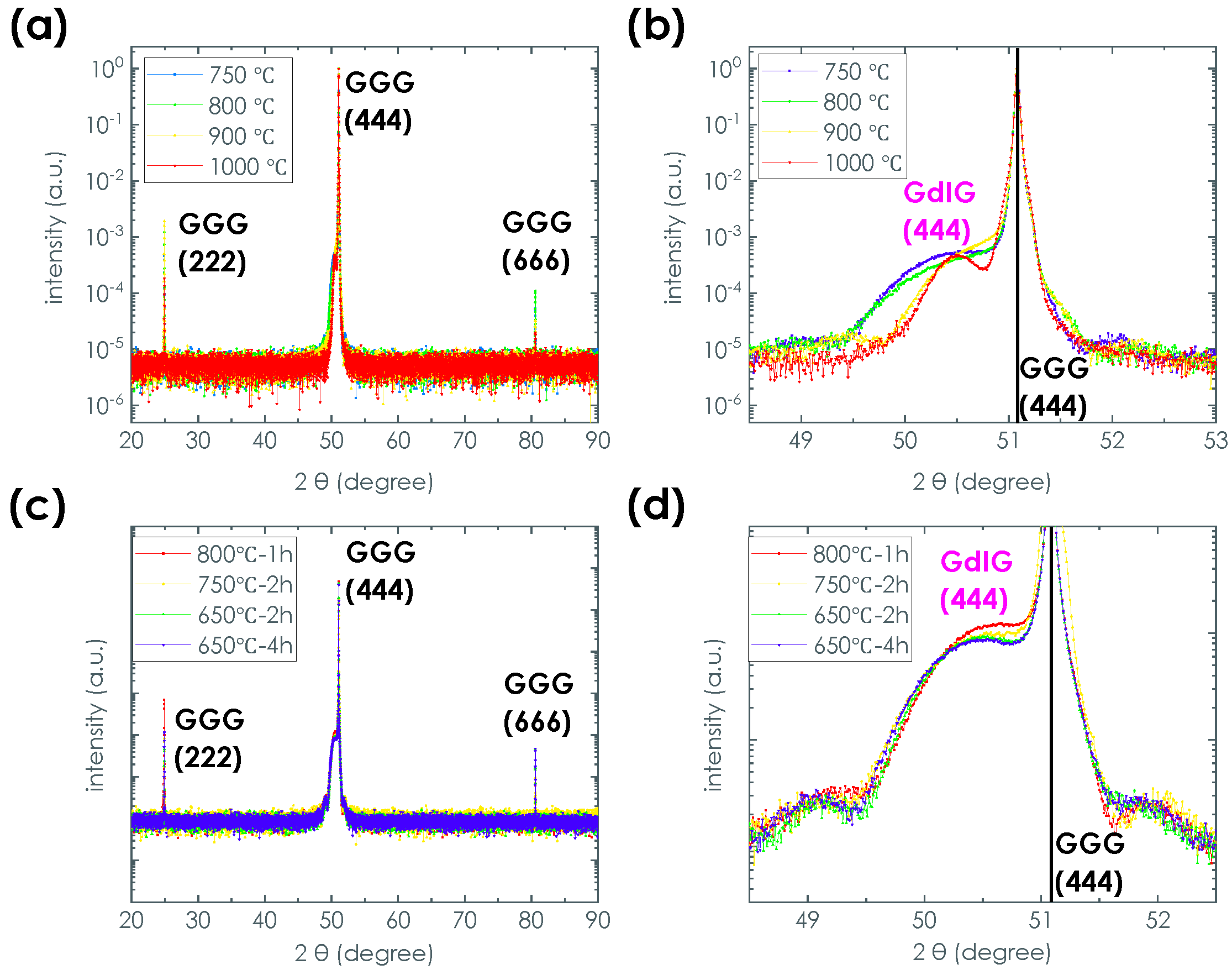
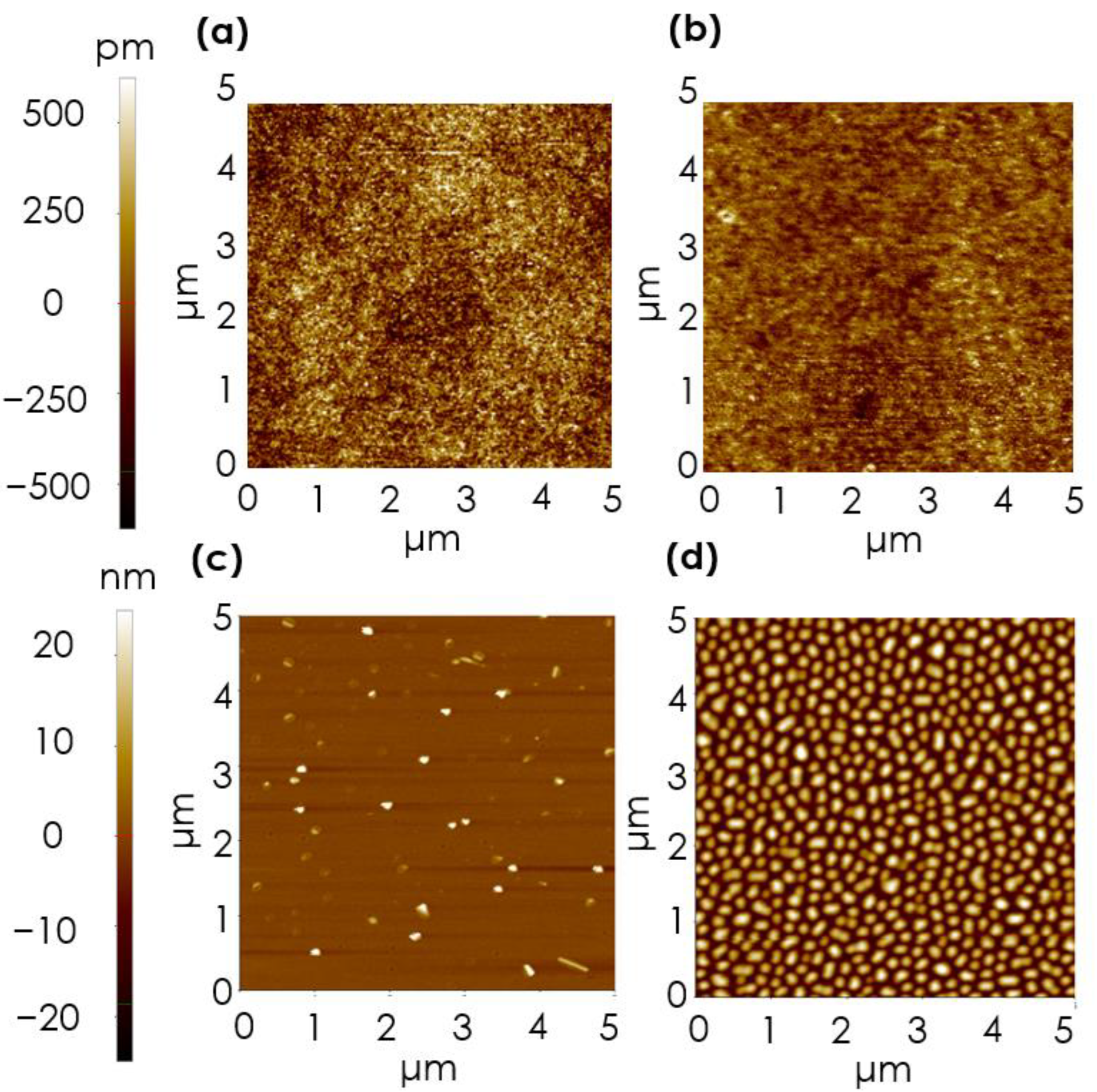
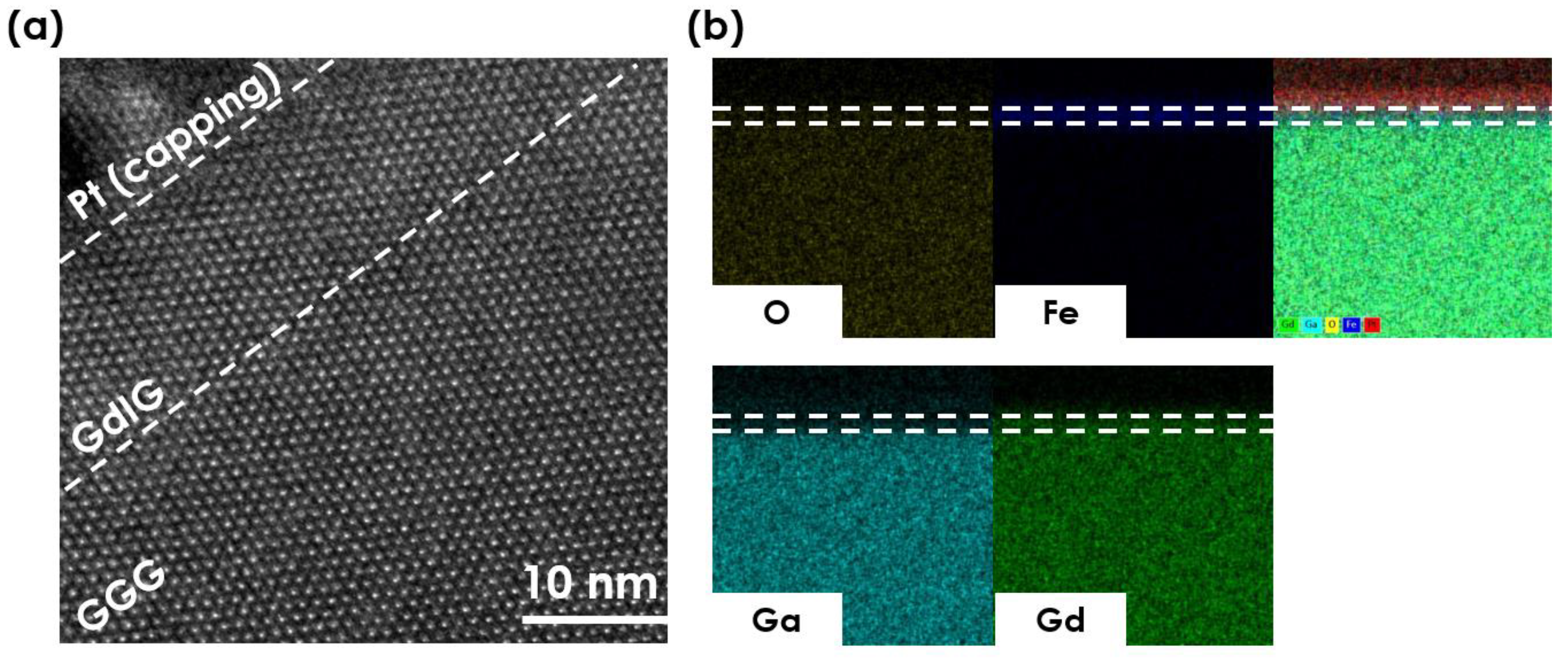
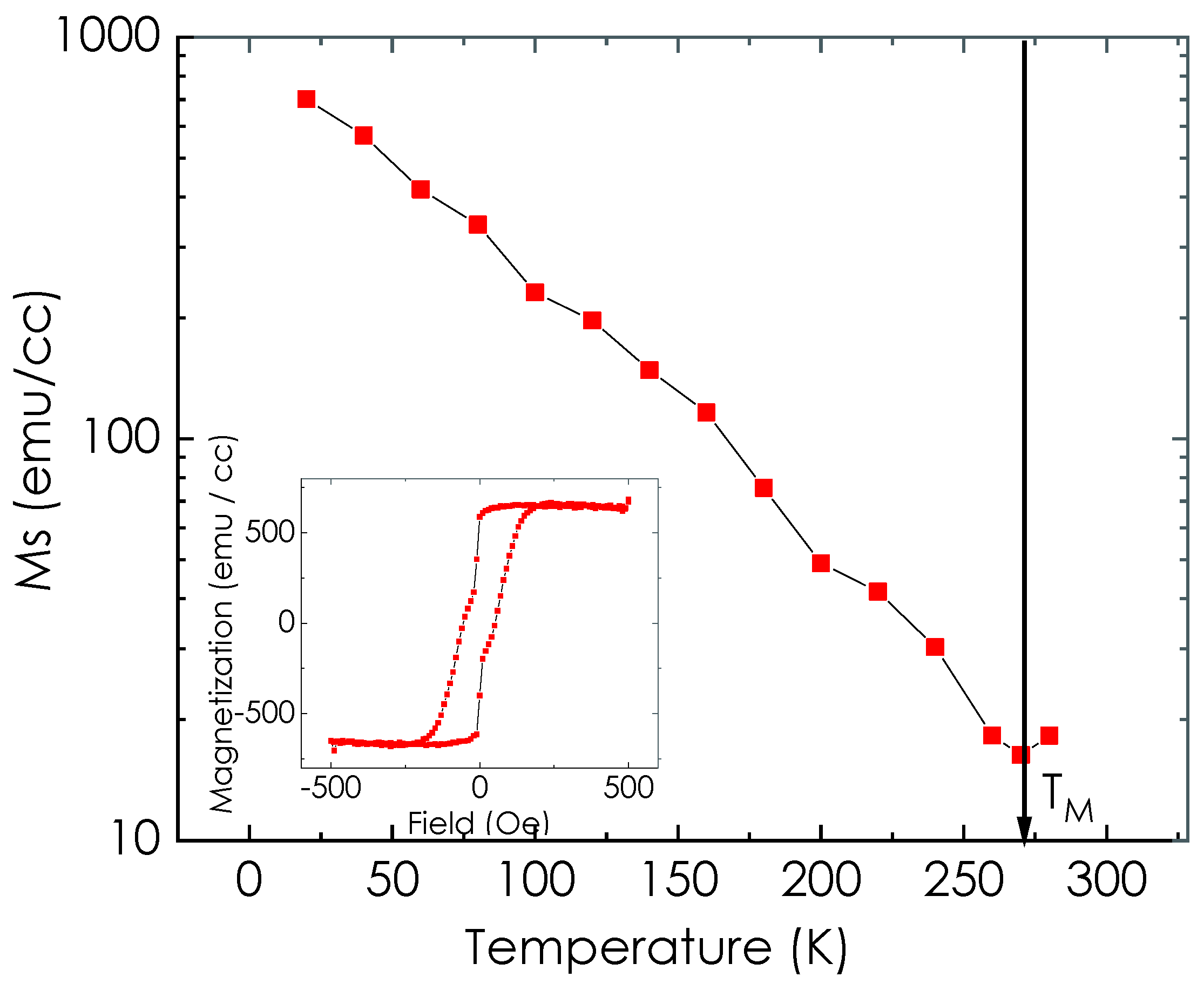
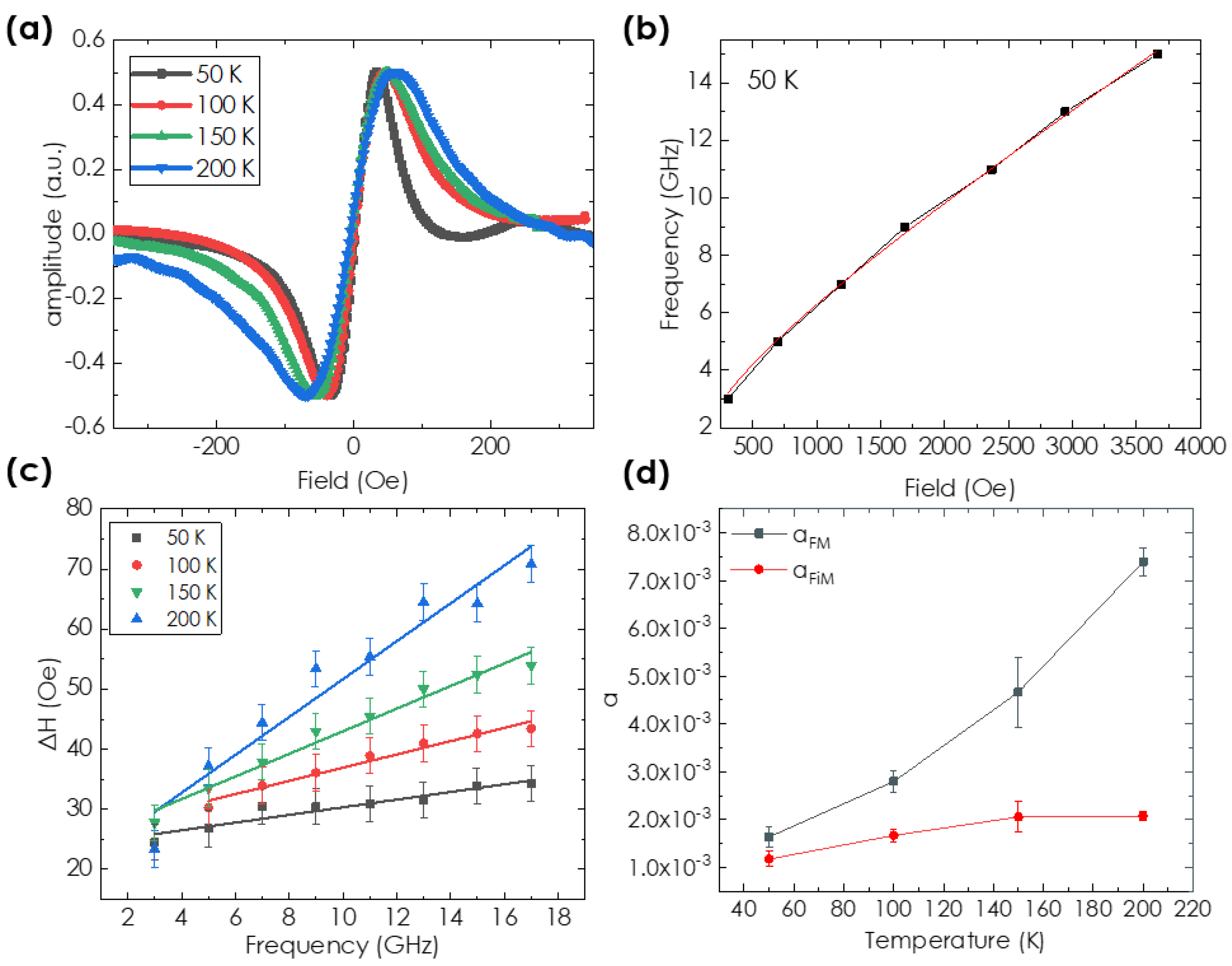
| Annealing Temperature (°C) | Ra (nm) |
|---|---|
| 750 | 0.14 |
| 800 | 0.08 |
| 900 | 0.71 |
| 1000 | 8.71 |
| Source | TM | Ms (emu/cc) |
|---|---|---|
| From Figure 4 | 270 K | 700 |
| From [16] | 280 K | 600 |
| From [17] | 300 K | 670 |
| From [9] | 280 K | 1300 |
| Temperature (K) | γeff (×107 T−1s−1) | (×10−3) |
|---|---|---|
| 50 | 1.78 ± 0.08 | 1.60 ± 0.22 |
| 100 | 1.85 ± 0.07 | 2.80 ± 0.22 |
| 150 | 1.81 ± 0.02 | 4.67 ± 0.74 |
| 200 | 1.75 ± 0.08 | 7.41 ± 0.3 |
Publisher’s Note: MDPI stays neutral with regard to jurisdictional claims in published maps and institutional affiliations. |
© 2022 by the authors. Licensee MDPI, Basel, Switzerland. This article is an open access article distributed under the terms and conditions of the Creative Commons Attribution (CC BY) license (https://creativecommons.org/licenses/by/4.0/).
Share and Cite
Kim, H.; Van, P.-C.; Jung, H.; Yang, J.; Jo, Y.; Yoo, J.-W.; Park, A.M.; Jeong, J.-R.; Kim, K.-J. Deposition of Crystalline GdIG Samples Using Metal Organic Decomposition Method. Magnetochemistry 2022, 8, 28. https://doi.org/10.3390/magnetochemistry8030028
Kim H, Van P-C, Jung H, Yang J, Jo Y, Yoo J-W, Park AM, Jeong J-R, Kim K-J. Deposition of Crystalline GdIG Samples Using Metal Organic Decomposition Method. Magnetochemistry. 2022; 8(3):28. https://doi.org/10.3390/magnetochemistry8030028
Chicago/Turabian StyleKim, Hyeongyu, Phuoc-Cao Van, Hyeonjung Jung, Jiseok Yang, Younghun Jo, Jung-Woo Yoo, Albert M. Park, Jong-Ryul Jeong, and Kab-Jin Kim. 2022. "Deposition of Crystalline GdIG Samples Using Metal Organic Decomposition Method" Magnetochemistry 8, no. 3: 28. https://doi.org/10.3390/magnetochemistry8030028
APA StyleKim, H., Van, P.-C., Jung, H., Yang, J., Jo, Y., Yoo, J.-W., Park, A. M., Jeong, J.-R., & Kim, K.-J. (2022). Deposition of Crystalline GdIG Samples Using Metal Organic Decomposition Method. Magnetochemistry, 8(3), 28. https://doi.org/10.3390/magnetochemistry8030028






